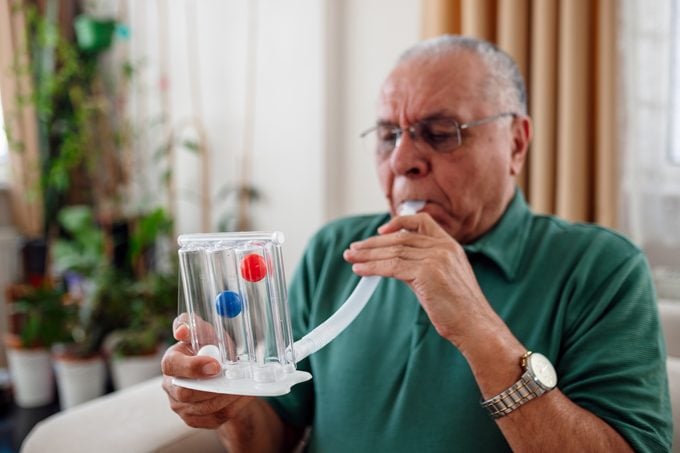Your Guide to Asthma Symptoms, Causes, and Treatments
Updated: Jul. 21, 2021
Asthma is a potentially deadly chronic illness that impacts 25 million Americans. Here's what to know about the symptoms and causes of asthma, and more.
On This Page
What is asthma?
Approximately 25 million Americans—or one in 13—have asthma, a potentially deadly condition.
Asthma is a chronic inflammatory disease of the airways that makes breathing difficult.
“It causes narrowing of the airways, hyperreactivity to normal exposures, and excessive mucus production that causes chronic variable symptoms of shortness of breath, cough, and wheezing,” explains Geoffrey Chupp, MD, an asthma expert with Yale Medicine and a professor at Yale School of Medicine.
Things that might not bother the average person—exercise, dust, or cold air, for instance—can inflame and narrow airways in people with asthma.
As you can probably imagine, breathing becomes tough. That’s when symptoms like coughing, wheezing, shortness of breath, and tightness in the chest set in.
Asthma is a chronic condition, and there is no cure. And unfortunately, approximately 10 people die each day because of asthma. But there’s hope: you can manage the condition with the right treatments. Keep reading to find out how.
Asthma causes
Asthma is commonly associated with allergies, and in many people, the inflammation may indeed by allergic in nature. But that’s not always the case. Dr. Chupp notes that in other people, the inflammation and disease aren’t driven by allergies.
“Ultimately, it appears that there are multiple inflammatory pathways driving asthma that are variably active in any given patient,” he says.
Allergies
Though they’re not always the cause for asthma, allergies can certainly play a role. Allergy-related asthma is the most common form of the disease.
In allergic asthma, allergens like pollen, dust, pet dander, cockroaches, and mold can trigger a reaction that leads to asthma symptoms.
In fact, you may suddenly develop asthma after coming into contact with a substance you didn’t realize you were allergic to, like bee pollen or mold.
Genetics
If someone in your immediate family has asthma, you are more likely to have it, according to the Centers for Disease Control and Prevention (CDC).
Additionally, allergic asthma may be the result of “atopy,” which is a genetic tendency to develop allergic disease. However, not all asthma is allergic asthma.
Environmental exposure
Exposure to environmental factors—including mold or dampness, dust mites, and secondhand tobacco smoke—is linked to the development of asthma, according to the CDC.
Air pollution may also lead to asthma.
Additionally, someone who has never had asthma can develop it if they are repeatedly exposed to low levels of mold, wood dust, or chemicals. Similarly, exposure to higher levels of those allergens and irritants all at once can cause asthma.
Respiratory infections
Viral lung infections, particularly in childhood when the lungs are still developing, can prompt asthma.

Asthma triggers
The allergens most likely to trigger asthma include:
If you have allergic asthma, spring and fall allergies can be especially triggering for your symptoms.
But allergens aren’t the only things that can trigger asthma attacks, Dr. Chupp adds. Other triggers can include:
- respiratory illnesses
- exercise
- smoke
- cigarette smoke
- air pollution, fumes, or other irritants in the air
- extremely high or low temperatures
- stress
- medications or certain food additives
- hormones
What happens during an asthma attack?
An asthma attack is when your body’s immune system reacts to one of your triggers.
“Your immune system is causing inflammation of your airways (bronchi) in response to things that you are inhaling,” Dr. Chupp explains. “It is an exaggerated response to substances in the environment. Less air gets in and out of your lungs, and mucous that your body makes clogs up the airways.”
Think of your airways as a tube. During an asthma reaction, that tube will swell, narrow, and possibly produce more mucus. The tube’s hole will be much smaller, which makes less room for air to flow.
Breathing, as you might imagine, can be difficult.
During an attack, you may experience coughing, chest tightness, wheezing, shortness of breath, and/or trouble breathing.
(Here’s what asthma feels like from people who know.)
Who is at risk?
While anyone can develop asthma, genetics play a big role.
“People with a mother or father with a history of allergies or asthma are at much higher risk of developing asthma,” Dr. Chupp says.
Childhood asthma may be common—the CDC estimates about 7 percent of American kids have it—but the disease can develop in adulthood too.
Gender may play a role in who gets asthma. The Asthma and Allergy Foundation of America (AAFA) notes that it’s more common in adult women than adult men. Interestingly, it is more common in young boys than young girls.
Race is also a factor. The National Heart, Lung, and Blood Institute says that black and Puerto Rican Americans are more likely to have asthma than people of other races.
How many people die from asthma?
According to the AAFA, adults are five times more likely to die of asthma than children.
Women are more likely to die than men, and boys are more likely than girls. Note that black Americans are almost three times more likely to die due to asthma than white Americans.
Asthma symptoms
Dr. Chupp says the most common asthma symptoms include:
- Coughing
- Chest tightness
- Wheezing
- Shortness of breath
- Trouble breathing

How is asthma diagnosed?
Asthma can be difficult to diagnose, especially in children under age five, notes the CDC.
A doctor will diagnose asthma based on a series of factors that include a detailed history of symptoms, lung function testing, allergy testing, blood work, and a chest X-ray, says Dr. Chupp.
Because symptoms of asthma overlap with symptoms of other conditions, your doctor will need to rule other causes, like other lung problems or heart failure.
A breathing test, called spirometry, can measure lung health and test how much air can be exhaled after a deep breath before and after using asthma medicine.
Types of asthma
A few different types of asthma (also called bronchial asthma) include:
- Childhood asthma
- Adult-onset asthma
- Allergic asthma (triggered by allergens)
- Nonallergic asthma (triggered by non-allergen causes)
- Exercise-induced bronchoconstriction (occurs during exercise)
Asthma may range anywhere from intermittent to severe persistent.
Asthma treatments
Treatments for asthma vary on a per-case basis.
Treatment comes down to two tactics: preventing an attack and treating an attack, Dr. Chupp says.
Quick-relief meds
These help stop an attack in its tracks. Some people use prescribed inhalers called bronchodilators, which help relax and open the airways in the lungs.
There are also inhaled steroids “to reduce inflammation,” says Dr. Chupp. These are considered a “quick-relief” treatment, meant to be used during an active attack.
Long-term control meds
These can help reduce the number and severity of attacks, according to the CDC, but they won’t help you in the midst of one.
Some examples are inhaled corticosteroids, longer-acting bronchodilators, and combinations of the two; there are also medications that calm inflammatory molecules called leukotrienes that can constrict airways.
If your asthma is triggered by allergies, you may be a candidate for allergy shots for long-term control—they can reduce your allergic reaction.
Depending on the asthma medication you use, you might take your meds in pill, inhaled, liquid, or injected form. If you inhale it, you can use an inhaler or nebulizer, a tool that turns liquid medication into a mist, making it easy to inhale. It’s important to learn proper use or it won’t be effective. Sometimes using a “spacer” can help people inhale more of the medication.
Lifestyle tips for preventing asthma attacks
Long-term control medication can help you prevent asthma attacks. But changes to your lifestyle can also help, as can developing an action plan (you can find advice on doing that from the Asthma and Allergy Foundation of America).
Essentially, an action plan is a step-by-step guide to managing attacks based on your symptoms and the medications you use. You can develop your plan in conjunction with your care provider; it will also help you recognize when it’s time to seek emergency help for yourself or your child.
Other measures you can take include:
- paying close attention to symptoms
- reducing your exposure to allergens and other triggers
- talking to your doctor about whether exercise might help
- getting yearly flu shots
- avoiding smoke
There’s also some research suggesting that taking fish oil or vitamin D may help with symptoms. You might also find added relief with these home remedies for asthma.
Personal stories
- My Childhood Illness Came Back After 16 Years—And Almost Killed Me
- I Had an Asthma Attack in My 20s, the Worst One in Years
- This Woman’s “Asthma Symptoms” Turned Out to Be Stage 4 Lung Cancer
- My “Asthma” Turned Out to Be Chronic Heart Failure
Products that may help with asthma
Depending on what you’re allergic to, Dr. Chupp says reducing allergen exposures at home with mattress and pillow covers and air filters can also be effective.
To get started, check out these allergy-reducing ideas:




